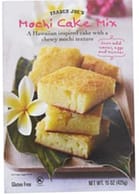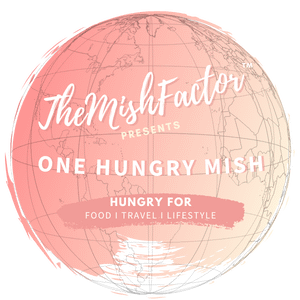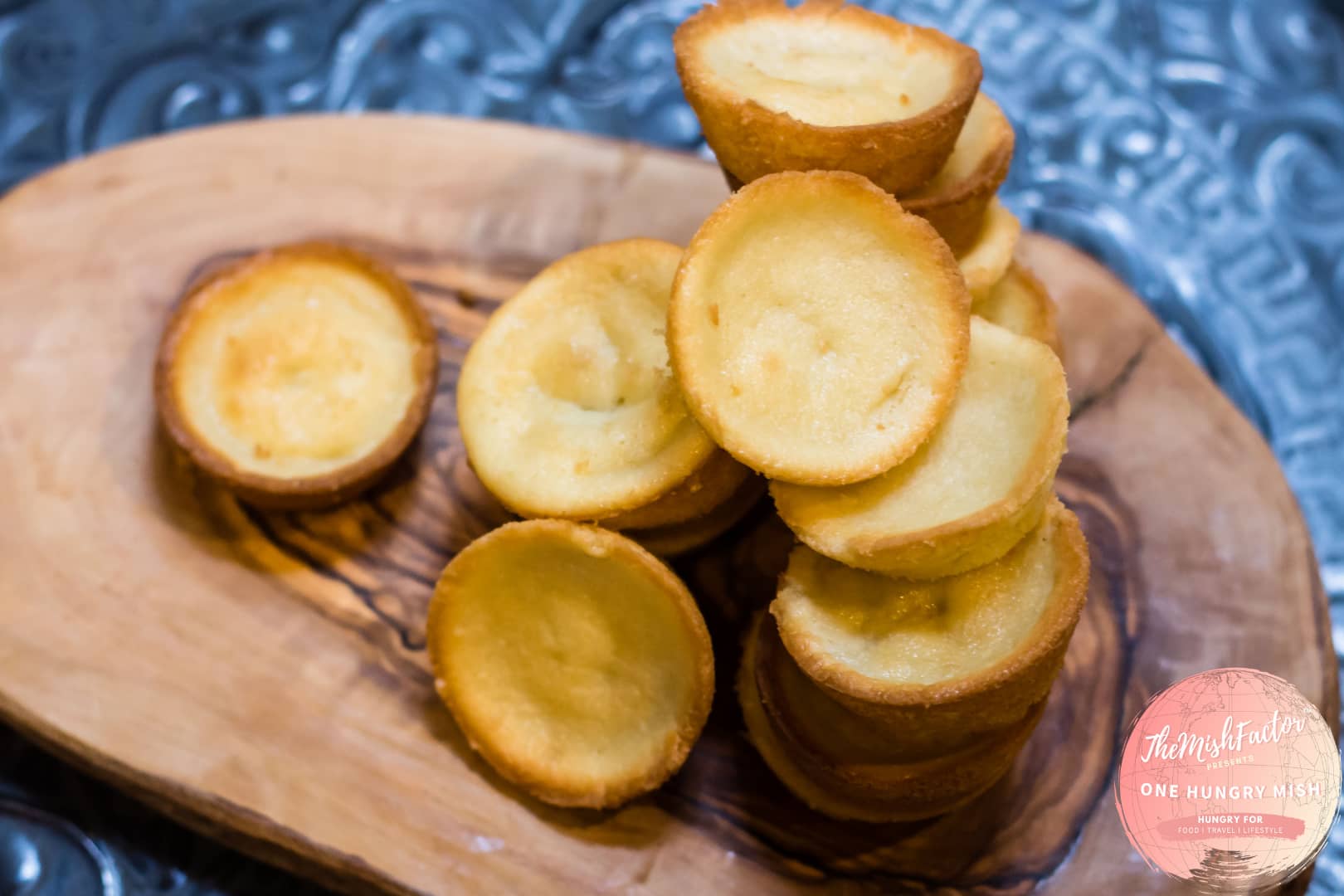Friends make everything better. In fact a coworker friend sent “Trader Joes’ Mochi Cake” my way and at first I was all, of course mochi cake is great duh. And then being me, it’s been mulling in the back of my mind all week. And I couldn’t get it out of my head. Like a craving you can’t quite shake, I found myself at Trader Joe’s staring down the box of pre-mixed cake flour. And I paused. I am all for boxed cakes–in the life pre-pandemic it took time and artistry to get cake ratios down. But this felt…familiar. Doable. So I put the box back. Because this played like Cloud Atlas‘ theme, hauntingly at home. And in this case,100% bibingka.
So here we are, breaking down Trader Joe’s Mochi Cake that was inspired from Hawaiian butter mochi cake. A sweet that could arguably be a love-child of Japanese and Filipino Hawaiian nostalgia because the overlap of bibingka (or even cassava cake and mochi) is striking.
Maybe it sounds silly, but for the mix you still have to melt the butter, get the water, eggs, mix and bake. Is it really that hard to just get the dry ingredients together myself? (Granted…I keep a full pantry on hand with Asian market goodies, so I would say that’s probably a point of privilege depending where you live.)

Naturally, this lead to a phone call with momma bear, because as much as I love this dessert, my Lolo and Lola were the bakers of the family, so she grew up with fond memories–and ideal palate–to relive bibingka with a side of sampalok (tamarind) and tira tira (a type of thin sugar) candies wrapped in a nostalgic chit chat.
So what is bibingka?
Okay let’s take a step back! Bibingka is a love of mine. There was a time period where if I were in a mall, and there was a bibingka cafe nearby…I would always “happen” to say something when we were near it to make sure a well timed air-con break with buttery bibingka wrapped in banana leaves was secured.

Is mochi cake bibingka? Isn’t mochi Japanese by name?
Kind of. If you look at the ingredients alone, the overlap is pretty spot on. Mochi cakes tend to use all the same ingredients except wrapping the cake in banana leaves and using evaporated milk to increase the creamy texture versus fresh milk (which may deviate due to historical need for canned products). However, traditional bibingka is made with a special type of oven–so one, my recipe will be fit for the standard oven of today and two, this may be a point of divergence since I frankly will not claim to be a Hawaiian Butter Mochi Cake expert.
On the Filipino Front…
Culturally, I can vouch for the Filipino migration (and therefore influences) to Hawaii before the Americans claimed the islands, though purely on an anecdotal level.
On my Lolo’s side of the family there was some drama, long before my mother was born, about his uncle taking the pineapple farms in Hawaii. Sadly joke’s on them because…Dole plantation and other shenanigans. Woof.
Regardless of the drama, it was not uncommon for Filipinos to migrate to Hawaii in the early 1900s. And whenever you come to a new place, you bring your culture with you, and over time it mixes with the new cultures and lifestyle of your new home and then you end up with a wonderful thing that is both reminiscent of it’s past yet wholly its own. So depending on how you want to interpret it mochi cake and bibingka are similar, however their contextual and cultural nuances are why we don’t just call all rice cakes mochi cakes or bibingka.

On The Japanese End…
There’s a whole rich history on mochi–and Japanese migration to Hawaii–as well. My first job was as a waitress in a mom-and-pop Japanese restaurant. The owner was a man from Hokkaido who talked only once about his hard relationship with mochi. I’ll let that sink in.
I know many people reading this only know mochi as the delightful treat. But mochi is much more than that. Mochi, in his childhood, was not just a treat filled with bean pastes to enjoy in festivity. It was a necessary way to make rice last through winter. He told us how he got so tired eating mochi all winter, that even half a world away, and many years since his Hokkaido days, he didn’t enjoy eating it.
I never pressed on it, partially because he was my boss, and partially because as a child of immigration, you pick up on harrowing moments of life and know when to tread with caution. If you look up Hokkaido mochi dishes, you’ll see there are countless variations and recipes utilizing mochi…debate-ably contending with the quantity of Korean tteok applications. Of course mochi as a food pre-dates my former boss’ life, being known to be a food consumed in the era of samurai, but in earnest to not turn this into a historical worm hole…
TLDR: it wouldn’t be too much of a stretch to say, whether Hawaiian mochi cake is a love child of Japanese and Filipino cultures or not, it’s flavor and popularity greatly make up of its ambiguous origin.
Ingredients
- 1 Egg
- 2 Tbsp Butter, melted
- 1 1/4 cup Rice Flour
- 3/4 cup Coconut Milk
- 1/4 cup Milk
- 1/2 cup + 2 Tbsp White Sugar (same as 10 tbsp)
- 2 tsp Baking Powder
- 1/4 tsp salt
- Banana Leaves (Optional but imparts a wonderful subtle bibingka-y flavor)
- Cheese Topping (Optional)
Steps
- Cream melted butter and sugar.
- Add egg and beat.
- Add dried goods in batches to make sure there’s no lumps. Should be a wet viscous batter.
- Preheat oven to 350 F
- If using banana leaves, warm up to shape within molds. If no leaves grease metal tins or use silicone molds.
- Pour halfway full and bake for up to 20 minutes in the middle rack.
- If using toppings add 5-10 minutes before baking is done (10 for cheese to brown, 5 for salted eggs and/or melty cheese with minimal browning).
- Cool and enjoy!
Notes:
-If using smaller molds, pictured on this post, for baby bibingka, bake for 15 minutes
-This will be more buttery, less sugary, and more bouncy than Trader Joe’s Mochi Cake, which to me is a plus given it takes at minimum 1 hour to bake and cool the cake (not including the multi step mixing) since this cools much faster and bakes in less than half the time.
-If dairy intolerant, can sub dairy milk with rice milk, oat and nut milks will impart a flavor, may be denser than expected.

So thank you friend for putting mochi cake on the mind, because if there’s one thing I love more than food, it’s seeing the nuances in how foods and cultures fold into one another, and at the very least I got to hear some heartwarming stories of my Lola’s baking from my momma bear.
Stay Hungry
XOXO
Mish ♥
P.S. If you really want to read more on the Filipino migration to Hawaii, here’s an academic publishing on it. It’s a bit old as 2021 is the 120th year since Filipinos were acknowledged to be in Hawaii and this academic print was made for the 75th year anniversary…but I don’t shame free academic readings! And likewise for some reading on Japanese migration to Hawaii.
Looking for other Filipino Eats?
- Sinigang (Savory + Sour Tamarind Soup)
- Ube Pie (Vibrantly Purple Sweet + Vegan/Gluten Free)
- Chicken Adobo (Savory Marinated Chicken)


July 3, 2021 at 6:03 pmThank you! When Trader Joe discontinued this boxed recipe mix, my friends and I were very disappointed. i’m going to try your recipe after I find banana leaves in the Bay Area (San Francisco.) I’m also going to read the history website you included.